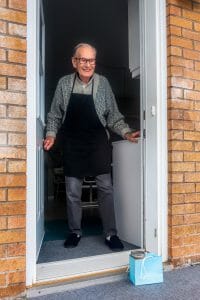To Move or Not To Move: Senior’s Residences Don’t Always Add Up

“I moved in because I no longer trusted my body or my health. I wanted the security of having a health centre on-site. As much as I wanted it, I wish I didn’t need it. My friends living outside have started treating me differently too. I’m not even sure if they were aware of it. But can we really blame them? after all, there is a part of me that does feel different. But do they no longer see me as just a regular person?”
– Sara (story submitted by Bianca Stern)
As we age, we may find ourselves struggling to maintain our home and a connection to our communities. Daily activities like laundry, stairs, and house cleaning can become increasingly difficult. As well, managing snow, appliances, and garden maintenance may be tasks we would rather not have to worry about. Perhaps our neighbourhood has changed so much that we feel isolated and no longer connected to it. All of these changes, in addition to the possibility of the onset or progression of a medical condition, may get us thinking about alternative living arrangements.
Whether you’ve had a health issue or are deciding whether to stay in your current home, an Occupational Therapist, or OT, can help you adjust your home so it’s safer and accessible. The average Ontario Senior’s Residence rental costs over $3,500 per month. And with inflation rates increasing rapidly, can you afford to move? And more importantly, do you want to move?
Senior’s residences are often a 1-room or small apartment. Yes, you don’t have to shovel snow but the cost to hire someone to provide services like this cost much less. To make your home safe and meet accessibility needs, talk to an Occupational Therapist to see what changes you can make to keep your quality of life and independence, not to mention your money! Find an OT in your area today.
Our best living arrangement may not be the same as someone else’s. What’s important is that our living arrangements are compatible with our activity interests, health, and financial needs. This could mean modifying a current home to make it safer and more comfortable, or moving into a more supportive or social living environment.
Finding the right place to live can be challenging and stressful. The earlier we assess our needs and how these needs may change over time, the more choice and control we will have. For many people, affordable, safe, and accessible housing limits the options available. Knowing what options are available is a first step to ensure that we can grow into old age in a secure, comfortable, and accessible living space with the necessary supports in place.
Ageing At Home

Research has found that most older adults want to age in place: to grow old in their own homes and communities for as long as possible. There are many reasons for wanting to age in place; it keeps us in a familiar place where good memories were made while maintaining our strong ties to the community.
Although over 85% of ageing adults prefer to age in place, research has found that many homes and communities do not have the structural features and access to support services to make this a safe and viable option. Occupational therapists are part of the home care team that supports us to remain in our homes for as long as possible.
Our changing abilities might prompt us to think about alternative living arrangements. However, decisions about where to live and with whom often depend on more than just our changing abilities. Some questions to consider include:
- Do I have supportive friends and family nearby?
- Are there adequate and accessible transportation options?
- Am I close to required health care supports?
- Do I have the resources to modify our home if needed?
- What kind of in-home supports might I need to perform my everyday activities?
- If I have a chronic illness, disability or other illness, what future supports might be necessary?
For some, venturing outside can become more and more difficult, placing us at risk of social isolation and inactivity. Yes, we want to age in place but we also want to participate in our communities.
Housing Options That Offer Support

“I don’t know exactly…I just feel that I am different than I used to be. I’ve had this feeling since I moved in here. In some ways I feel like this place will allow me to be more active than I have been in a long time –there’s so much to do…But it’s strange…the moment I step outside of this building I feel more like the ‘old’ me…the person I was before I moved here. I’ve also noticed that my friends living in the outside community see me differently too. Somehow they seem to think I’m more helpless now. They offer to help me with all sorts of tasks…which I appreciate…but they should know that I can still do these things for myself. I can’t put my finger on it. Maybe it’s because I just don’t feel like I have as much control over my life. My body is changing and I find that my memory…my memory just isn’t as good as it used to be. But this didn’t start when I moved in here…I’ve been noticing these changes for some time.”
– Ben, (Story submitted by Bianca Stern)
The list of living arrangements are numerous and the decision-making process can feel overwhelming. Below is a list of housing options that can be discussed with your health care providers, family or friends.
- Independent living options will allow us to maintain personal living quarters, preserving our privacy and only choosing the support services we wish to receive.
- Assisted living is for those who do not need round-the-clock medical care, but need personal care services that can be delivered at home or in an independent living community. Assistance can include preparing meals, getting to the bathroom, or travelling to appointments.
- Long-Term Care is best for those with serious, ongoing health conditions or disabilities that require a high level of medical care that cannot be met in our home. Assistance is provided for everyday activities, such as getting in and out of bed, bathing, and dressing.
- Co-Living is a new way of looking at interdependent living in a community. Co-living or co-housing involves joining with long-time friends or roommates in a communal house where each person has a private room but shares communal spaces.
- Living with a child or relative has perks. It allows our younger family members to provide care in our time of need, and older members to provide wisdom and mentorship. We may feel more comfortable with care provided by a loved one, particularly intimate tasks, than from a hired caregiver. We can also benefit from the company of our loved ones, which can prevent social isolation that is shown to be detrimental to our health and well-being.
Occupational Therapists can Support Decision-Making on Where We Choose to Live
 “After a serious fall which made managing at home and getting around difficult, I moved into a retirement home. Several months later, my two daughters noticed I was depressed and had withdrawn from social activities. Everything seemed harder to do and I had lost the energy I once had.
“After a serious fall which made managing at home and getting around difficult, I moved into a retirement home. Several months later, my two daughters noticed I was depressed and had withdrawn from social activities. Everything seemed harder to do and I had lost the energy I once had.
At the insistence of my daughters, I began receiving home-based occupational therapy. My world has since reopened. One of the innovations my occupational therapist devised was a specialized electric wheelchair which allows me to move about the home, attend activities, and access my neighbourhood. With the energy issues, my occupational therapist showed me how I could balance my daily activities throughout the week, so I had enough energy for the things that were most meaningful to me.”
– Duncan, a dentist and an associate Professor at the University of Toronto’s Faculty of Dentistry retired
from active practice at age 73 (story submitted by Barbara Cawley)
Occupational therapists consider who we are and how our living arrangements can help us thrive.
Should we (or someone we love) wish to stay where we are, but have concerns about remaining secure, content, and engaged, an occupational therapist can walk us through the many options based on our unique circumstances. For example, occupational therapists:
- Collaborate with design/renovation professionals to ensure our needs and preferences are met in the process. Home modifications or renovations can be permanent structural changes, or more temporary alterations to the environment, such as ramps, stair glides, or level-access showers, to enable our safety.
- May recommend adaptations, assistive devices, and tools that can assist us to remain safe and active in our own home and community.
- Assess mobility needs within the home and community to determine if a device, such as a cane, walker, wheelchair, or ramp is needed.
- Connect us to the support services that match our care needs. This might be a recommendation for home care services or a conversation about considering transitioning to a more supportive living environment.
Occupational therapists can help us through the complexities of deciding where to live in the older years of our lives.


